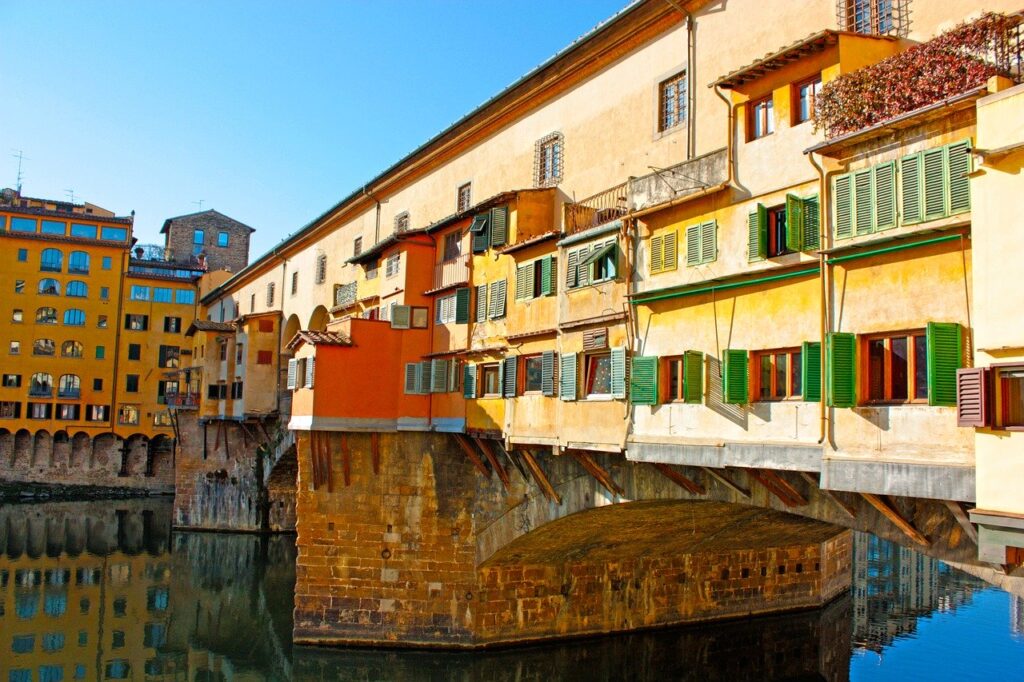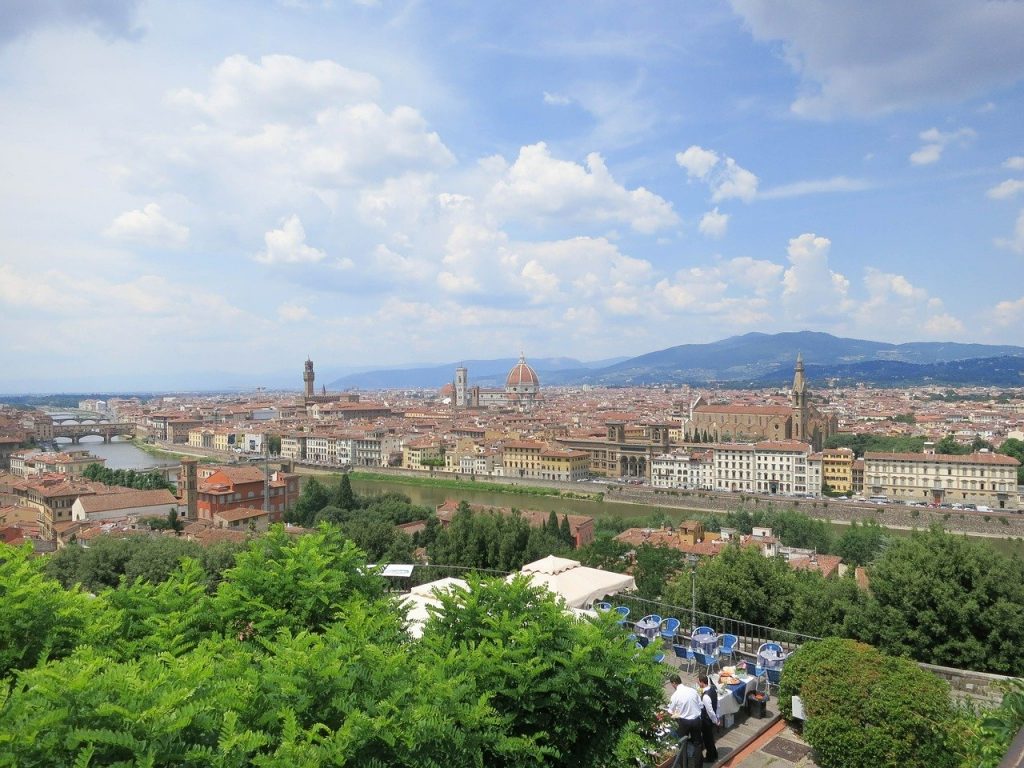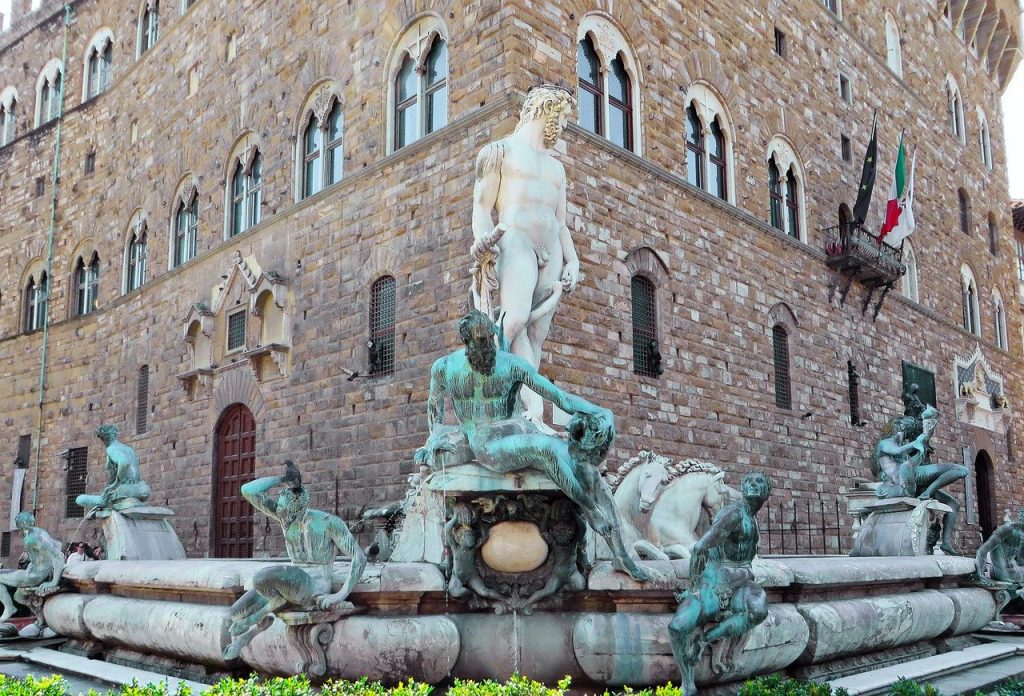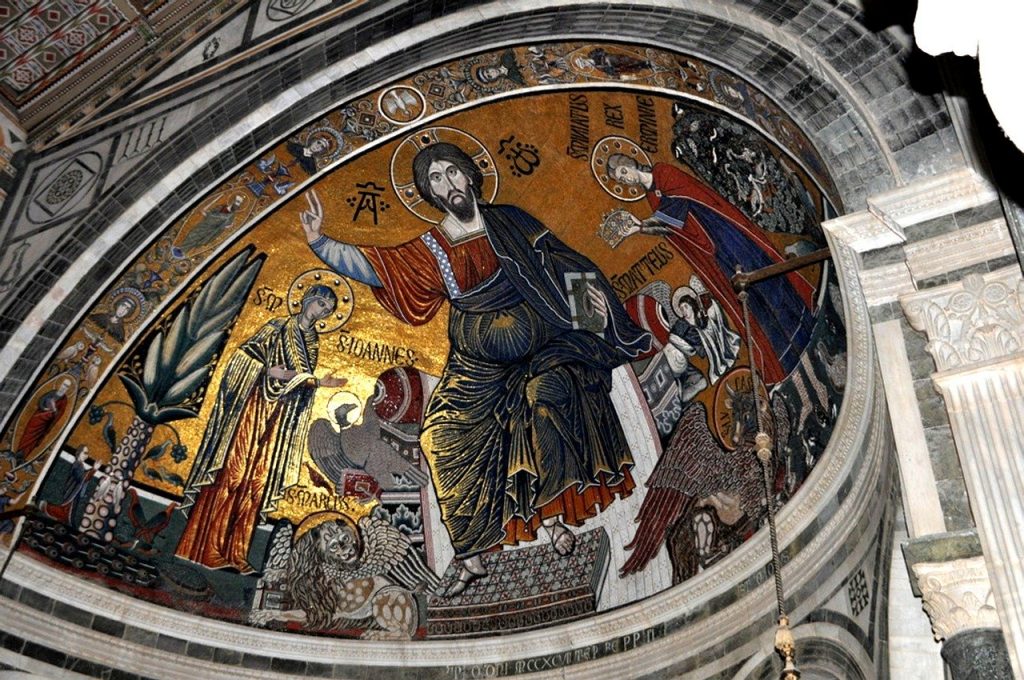Florence is probably our favourite city in Italy. The city is simply iconic, jam packed full of the most incredible art and architecture. Every corner you turn, you’ll be amazed at another beautiful building or a stunning view. But we are also equally aware that holidays and city breaks can be expensive and some of you may need to be able to enjoy some activities that will be a bit kinder on your pockets! So here’s our guide to the top 10 free things to do in Florence.
1. Soak up the atmosphere in the Piazza del Duomo
The Piazza del Duomo is, for us, the heart of the city of Florence. It is also a UNESCO World Heritage site. It’s where you will find Florence’s Cathedral – the Cathedral of Santa Maria del Fiore – as well as Giotto’s Campanile, the Baptistry, the Loggia del Bigallo, the Opera del Duomo museum and the Arcivesconvile and Canonici’s palace. You may be surprised at how much you can see and do here for free.
For a start, access to the cathedral is free through marked entrances. It’s just that you won’t be able to climb to the top of the Duomo without paying a fee. With making payment, you also won’t be able to visit the crypt amongst other things. Make sure when inside you make a point of looking out for the clock that was painted by Paolo Uccello, one of the greatest artists of the Renaissance period. It is located above the main entrance and is one of just a handful of clocks anywhere in the world that that measures time from sunset to sunset, with hands that move anti clockwise. Because the 24th hour indicates sunset not midnight, the clock is adjusted a number of times during the year.

Also free in the Piazza del Duomo is the opportunity to admire the Baptistry doors. Whilst you will need to pay for a ticket to enter the Baptistry of San Giovanni, this building is arguably most famous for its bronze doors which depict The Last Judgement and these can be seen without any ticket required! In actual fact, these are replicas of the original doors which can be found in the Museo dell’ Opera.
2. Enjoy the street art
Whilst much of Florence’s most famous art requires an entrance ticket (the Uffizzi, Accademia Gallery or the Bargello Museum for example), there is a very different art scene that can be enjoyed simply by strolling through the streets of the city. Clet Abraham (known more commonly as CLET) is a contemporary artist that has found an ingenious way to bring art to the masses. Using removable stickers, he cleverly adapts Florence’s street signs, So wherever you are wondering in Florence, look out for his artwork. You will be amazed how much there is to discover. If you want to meet the man himself, head to his studio which is located in the San Niccolo neighbourhood of the city.

3. Walk across Florence’s bridges
Six bridges span the River Arno in Florence, all but five of which were sadly destroyed by Hitler’s troops as they retreated from the city in WWII. However, the most famous of the bridges in Florence – the Ponte Vecchio – was actually spared destruction on Hitler’s orders. This bridge spans the River Arno at its narrowest point. Dating back to 1345, it is also the oldest surviving bridge in Florence. It is lined with small shops that would once have been home to butchers, blacksmiths and tanners but which are now home to a number of jewellers. Whilst you won’t be able to shop for free in the famous shops that now line its sides, it’s an iconic bridge which we think is a delight to walk across. Incidentally, sitting above the bridge is the Vasari Corridor. Dating back to 1565, this was built by Vasari on the orders of Cosimo I de Medici to link the Palazzo Vecchio with the Palazzo Pitti.

After their destruction in the 1940s, the other 5 bridges were either reconstructed to appear as they did prior to the war, or were built in a much more modern style. The Ponte Santa Trinita is the neighbouring bridge to the Ponte Vecchio along the River Arno. Walk across it to enjoy the most wonderful views of the adjacent Ponte Vecchio. The other bridges are the Ponte San Niccolo (which is more modern), the Ponte alle Grazie (which at one point was similar to the Ponte Vecchio in that it was lined with shops and even chapels), the Ponte alla Carraia and the Ponte Amerigo Vespucci.
4. Visit the incredible parks and gardens of Florence!
Florence is not just a city of buildings. It is also a city filled with public parks and gardens, many of which offer free entry. The Parco delle Cascine is the largest of these stretching over an area of nearly 400 acres. Once the hunting ground of Cosimo I de Medici, it’s now a beautiful space to relax and stroll in under tree lined avenues.
Also well worth a visit is the Giardino delle Rose. This is a park situated in the Oltano district of Florence on the Southern slopes of the Monte alle Croci and close to the Piazzale Michelangelo. It was designed by Giuseppe Poggi and is now home to over 350 different varieties of rose as well as lemon trees and a Japanese garden. Again, entry is free and it’s open all year round but, if you can, it is worth visiting in May and June when the roses will be in bloom.
The Iris Garden is another free garden which is located near to the Piazzale Michelangelo. Once again, we recommend you try and visit in May when the flowers will be in bloom.
5. Watch the sun set from the Piazzale Michelangelo

Another activity in Florence that will cost you absolutely nothing is a walk to the Piazzale Michelangelo where you can enjoy the most spectacular views over the city. Visit on a clear day (and at sunset if you can when it’s even more special) and you will enjoy views of many of the afore-mentioned bridges that span the River Arno as well as the Duomo and Palazzo Vecchio. The piazza was originally the work of the 19th century architect, Giuseppe Poggi, and it’s dotted with copies of sculptures by Michelangelo.
6. Visit the world’s oldest pharmacy
It may seem a strange activity to enjoy on holiday, but a visit to the Officina Profumo-Farmaceutica di Santa Maria Novella (one of the world’s oldest pharmacies) is a must on any trip to Florence. It is located in the monk’s infirmary in the Basilica Santa Maria Novella and was established in 1221 by Dominican monks. OK – so you won’t be able to pick up one of the monk’s incredible perfumes or remedies for free but, even if you aren’t going to be shopping there, the shop is still worth seeing. It is absolutely stunning with original frescoes, gilded ceilings and elegant wooden cabinets housing old glass medicine bottles. You can’t help but be struck immediately by the wonderful smells and fragrances of the herbs and spices used to make the products on sale here.
7. Admire the sculptures in the Piazza della Signoria

The Piazza della Signoria is an L-shaped square that is home to the Palazzo Vecchio. Back in the day, the square would have been at the very centre of Florentine politics. The bell of the Palazzo Vecchio would once have called the city’s citizens to meetings here but these days the piazza tends to be more of a meeting point for tourists. Holidaymakers flock to the square to admire the wealth of statues that have their home here. The most famous of these is the replica of Michelangelo’s David but there are a number of other statues here, including Giambologna’s Rape of the Sabine Women (1583) and a bronze statue of Perseus beheading Medusa (1554). The piazza is also home to the bronze and marble Fountain of Neptune. This dates back to the 16th century and was the work of Bartolomeo Ammannati, commissioned to celebrate Cosimo de Medici’s gift of clean water to the city of Florence as well as to celebrate the marriage of Francesco de Medici I to the Grand Duchess Joanna of Austria.
8. Visit the markets of Florence

We make no secret of the fact that part of our love of Italy is closely intertwined with our love of food! In our opinion, no trip to Florence would be complete without visiting one of the many weekly markets in the city. The biggest food market in Florence is the Mercato Centrale. You’ll discover stallholders selling meat, poultry, fish, ham, oil and cheese on the ground floor here and, by visiting it, you can get a real sense for how the locals live in the city. Other markets in the centre of the city include the Mercato delle Pucli, the Mercato Nuovo, the Mercato San Lorenzo and the Mercato Fierucola. All are a really good way to get a taste for Florentine life.
Incidentally, in the run up to Christmas, there are also a number of other temporary, seasonal markets in Florence which are again free to enter. The largest and most famous of these is, without doubt, the Christmas market in the Piazza Santa Croce which runs from the end of November. At this time, the piazza is filled with charming wooden huts where stall holders sell everything from crafts to furnishings and from food to Christmas gifts.
9. Visit some of Florence’s lesser known churches
Whilst some of Florence’s most famous churches come with entrance fees attached, not all do. One of Florence’s less well known (and free) churches is the Church of Ognissanti. Few have heard of it but it’s actually home to the robes of St Francis of Assisi and is also the resting place of Botticelli. There are works by this incredible Renaissance artist in the church too including his painting of a fresco of Saint Augustine in his study. There are also some impressive works by Ghirlandaio here, including his Last Supper along with frescoes of the Madonna of Mercy and the Pieta.

Another of Florence’s churches well worth visiting is the 11th century Romanesque Church of San Miniato al Monte, not least for the spectacular view of the city that can be enjoyed from the front of it. It is arguably one of the most beautiful Romanesque churches in Italy with a nave covered with mosaics depicting the animals and signs of the zodiac.
Other churches in Florence providing complimentary access include the Church of Santa Felicita (a tiny Renaissance church once attended by the Grand Dukes!), the Church of Santissima Annunziata (whose Baroque interior is home to the Madonna del Sacco by del Sarto) and the Church of Santa Trinita (home to frescoes by Ghirlandaio).
10. Take part in one of Florence’s many festivals
Italy is renowned for its annual jam-packed calendar of festivals. Florence is no exception. These kick off early in the year on 6 January with Epiphany when a ‘Cavalcade of the Three Kings’ processes through the streets of Florence. However, there are festivals to be celebrated in most months of the year so whenever you visit, you will hopefully be lucky enough to take part in something. One of our favourites is the Carnevale every February when enormous, colourful floats parade through the city to the Piazza della Signoria. Next comes the feast of the Annunciation in March when another parade fills the streets, however this time participants will be dressed very differently in traditional Medieval costumes. Then in April is the Scoppio del Carro. This Florentine festival dates back over 400 years. Central to it is the pulling of a wagon through the city by white oxen. The wagon is filled with fireworks which then explode when hit with a dove-shaped rocket fired from the altar of the Cathedral of Santa Maria del Fiore. La Festa della Rificolone (Festival of the Paper Lanterns) in September is one of Florence’s prettiest events when the residents of Florence wander through the streets carrying paper lanterns lit by candles. All these festivals offer an opportunity to witness Florentine life at its most spectacular and all can be enjoyed for free.
If we’ve whetted your appetite enough, and proven that a trip to Florence doesn’t have to burn a hole in your wallet, then take a look at the phenomenal portfolio of villas and apartments in Florence available to rent for your next holiday in Italy through Bookings For You.


